A lot of time and energy is spent looking at the market share each search engine commands. But why? Google is still the king of search and there is little evidence to suggest this is going to change in any material way. That doesn’t mean there aren’t some interesting search trends to keep an eye on.
Here are four search trends I’m watching.
Search Volume
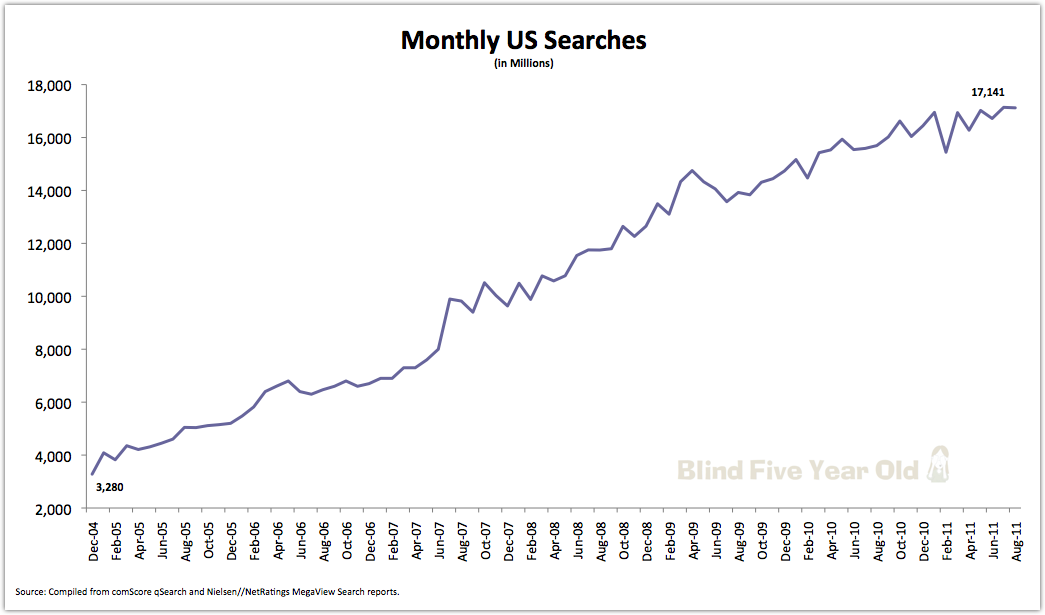
Compiled from comScore qSearch and Neilsen//Netratings Megaview Search reports, this graph shows explicit monthly US desktop search volume. From a distance the trend looks rosy and those in the search industry have been riding a wave of growth. Looking closer, there’s a disturbing trend.
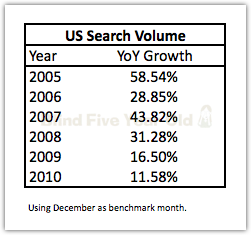
The rate of growth has slowed dramatically and 2011 is tracking toward single digit growth. I’ve written before about how this may create a shakeout within the SEO community. You can’t just show up, half-ass the job, and still wind up catching that huge wave of increased search volume.
Search Demographics
Why is the rate of search growth slowing? Part of the reason revolves around the penetration rates of Internet usage and search adoption. A May 2011 Pew Internet report showed that 78% of adults use the Internet and that 92% of them use a search engine to find information. 22% to go right? Wrong.
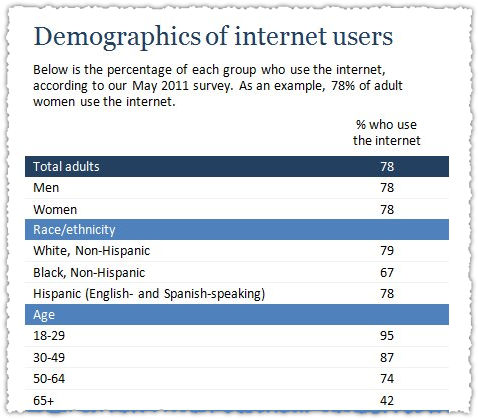
You’re simply not going to make much headway in the 65+ group based on normal adoption curve theory combined with illness and attrition.
What’s more, we know that those younger than 18 are on the Internet and already use search. These two factors combined show that a vast majority of the target population (in the US) have already adopted search. There’s still room for growth, but it’s unlikely to be at the rates we’ve seen in the past.
But the changing demographics of search also has profound implications. We know that late adopters and laggards exhibit different behavior from innovators and early adopters. How will Google address these differences, particularly in how it measures user behavior and satisfaction as a feedback signal?
The 72 year old Internet novice may have a very different perception of what constitutes a trustworthy site than a 32 year old Internet veteran. This is one of the biggest reasons why I remain intensely interested in the composition of Google’s ‘human raters’ panel.
But it’s not just late adopters and laggards that are changing this dynamic. Some studies show that an over reliance on Google is eroding search skills, even among the young, whom many would expect to be more technologically savvy.
Who is searching and how they search are important variables. These are the real SEO questions.
Search Cannibalization
How people search is also influenced by the devices they’re using. In the last three years smart phones and tablets have become far more ubiquitous.
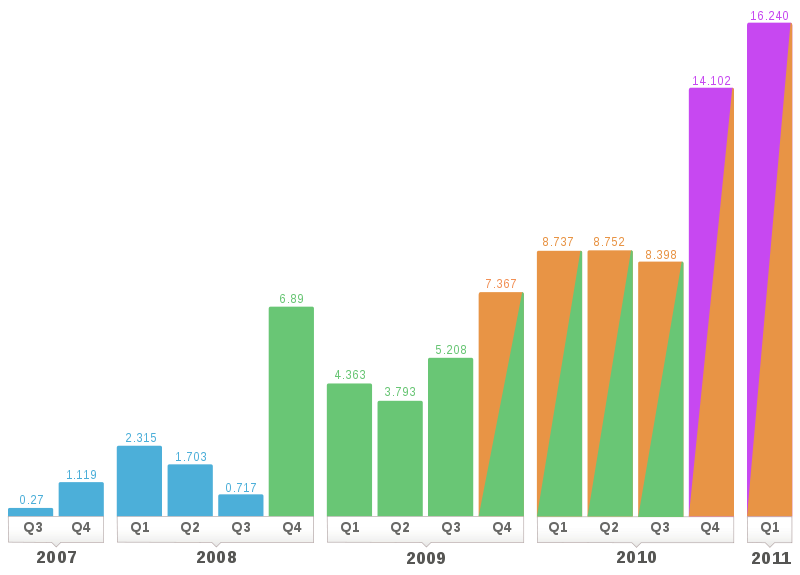
The graph above shows iPhone sales per quarter. And sure enough we’ve seen a rise in mobile searches as well.
Over the last two years, we have seen 5X growth in our mobile traffic.
That’s what Amit Singhal said during the June 14, 2011 Inside Search Event. He went on to show that the rate of mobile search growth has been similar to the early growth of desktop search.
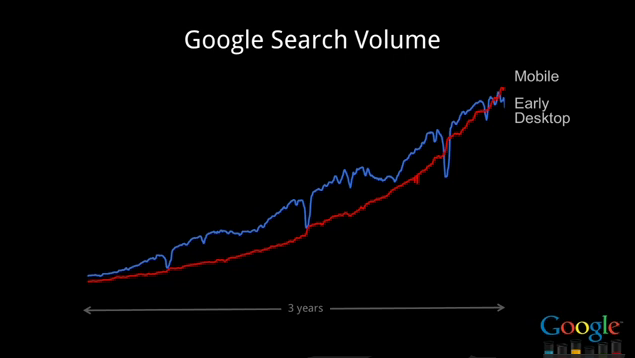
Many claim that mobile search is additive, that these searches don’t take away from desktop search. Perhaps that was true in the beginning but even Google acknowledges that mobile searches are getting more interesting and complex.
Here’s what Scott Huffman had to say about it during that same June 14, 2011 Inside Search Event.
If you went back a few years and looked at the mobile searches that we were getting then, you might say, “Gee, Amit, that’s kind of a grandiose statement.” Besides not getting very many mobile searches then, the mobile searches that we did get, honestly were kind of boring, right?
People did pretty simple things. They would look up a stock price. They would look up the weather, things like that. We saw people just doing very simple search tasks on mobile phones.
An amazing thing happened when the mobile phone became a powerful computer in my pocket, with the advent of devices like the Android and iPhone and others. And sort of overnight, we saw our mobile search stream really transformed to something very interesting, where all of a sudden, we were still seeing people doing some simple things on mobile, but we were also seeing them do very complex search tasks, things like planning a trip, doing research, things that required complicated searches to get done.
Not enough for you? In addition, Google predicts that 15% of all ‘Black Friday’ queries will be mobile and an RBC report places the mobile search percentage at 9% today and rising to 20% by 2012. Furthermore, IDC predicts that more people will access the Internet via a mobile device than through a PC by 2015.
More recently we have the iPad tablets. The experience is more closely aligned to desktop search, but Google has already acknowledged a difference by rolling out a specialized tablet interface.
So, lets go back to those search volume numbers above. When I start matching up iPhone and iPad unit sales numbers on the same timeline it makes me believe that search cannibalization is very real.
Clearly the rate of growth for desktop search is declining. But perhaps total search volume is still growing at a more robust rate? It’s tough to tell really.
But the shift in search platforms creates new challenges and opportunity. Our understanding and expectation of search traffic is based on desktop search activity. The numerous click through rate by position studies may become unreliable in a short span of time.
With less real estate available in both of these new platforms, how much more important is it to be at the top of the results?
Search Diffraction
Not only do new platforms, and their interfaces, change our search patterns but we have new ways to input search – voice and image. In the last year alone, voice search on mobile saw 6X growth.
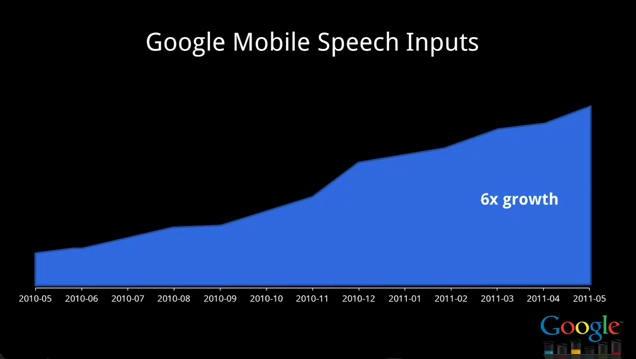
Mike Cohen drove the point home with the following piece of information.
To give you an idea of the volume of speech, every day these days, roughly two years of nonstop speech comes into our system.
The way we type and talk are different. If voice search becomes the more dominant method, how will you adapt to ensure you’re optimized? Are voice searches longer or shorter? Precise or broad? Is the rate of refinement on voice search higher or lower? Will people use a combination of voice search and text search to complete their searches? I don’t know, but I’m sure going to do my best to figure it out.
We haven’t even touched on image search. The new drag and drop functionality is probably not being used much now but I believe it will be in the future. And don’t forget Google Goggles. That’s search too!

Search is no longer monolithic in nature and the continuing refinement and subtly of search will make SEO both more difficult and important.
TL;DR

As the number of new search users slows and the demographics of search users changes, it’s time to begin tracking the shift in search platforms in earnest and understand how new platforms and search inputs will change the SEO industry.
The Next Post: Google Influence Metric
The Previous Post: PageRank Ponzi

2 trackbacks/pingbacks
Sorry, comments for this entry are closed at this time.
You can follow any responses to this entry via its RSS comments feed.